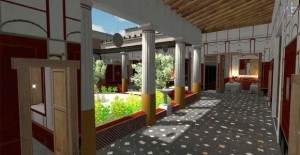An international team of researchers led by Lund University archaeologists has virtually reconstructed a large house of the Pompeian banker Lucius Caecilius Iucundus. A research paper about the virtual reconstruction is published in the journal SCIRES-IT. After the 1980 earthquake in Italy, the Pompeii curator invited the international scientific community to help document the ancient Roman town.The Swedish Pompeii Project was therefore started at the Swedish Institute in Rome in 2000.
The goal of the project was to survey, record and analyze an entire Pompeian city-block, Insula V1.
The district was scanned during the field work in 2011–2012 and the first 3D models of the town have now been completed.
The models show what life was like for the people of Pompeii before the volcano eruption of Mount Vesuvius.
The archaeologists have even managed to complete a detailed 3D reconstruction of the House of Caecilius Iucundus. “By combining new technology with more traditional methods, we can describe Pompeii in greater detail and more accurately than was previously possible,” said co-author Dr. Nicolo Dell’Unto, a digital archaeologist at Lund University.
Among other things, the archaeologists uncovered floor surfaces from 79 CE, performed detailed studies of the building development through history, cleaned and documented three large wealthy estates, a tavern, a laundry, a bakery and several gardens. In one garden, they discovered that some of the taps to a stunning fountain were on at the time of eruption — the water was still gushing when the rain of ash and pumice fell over Pompeii. They occasionally also found completely untouched layers.
House of Caecilius Iucundus from Sci-News.com on Vimeo.
Ask me anything
Explore related questions





